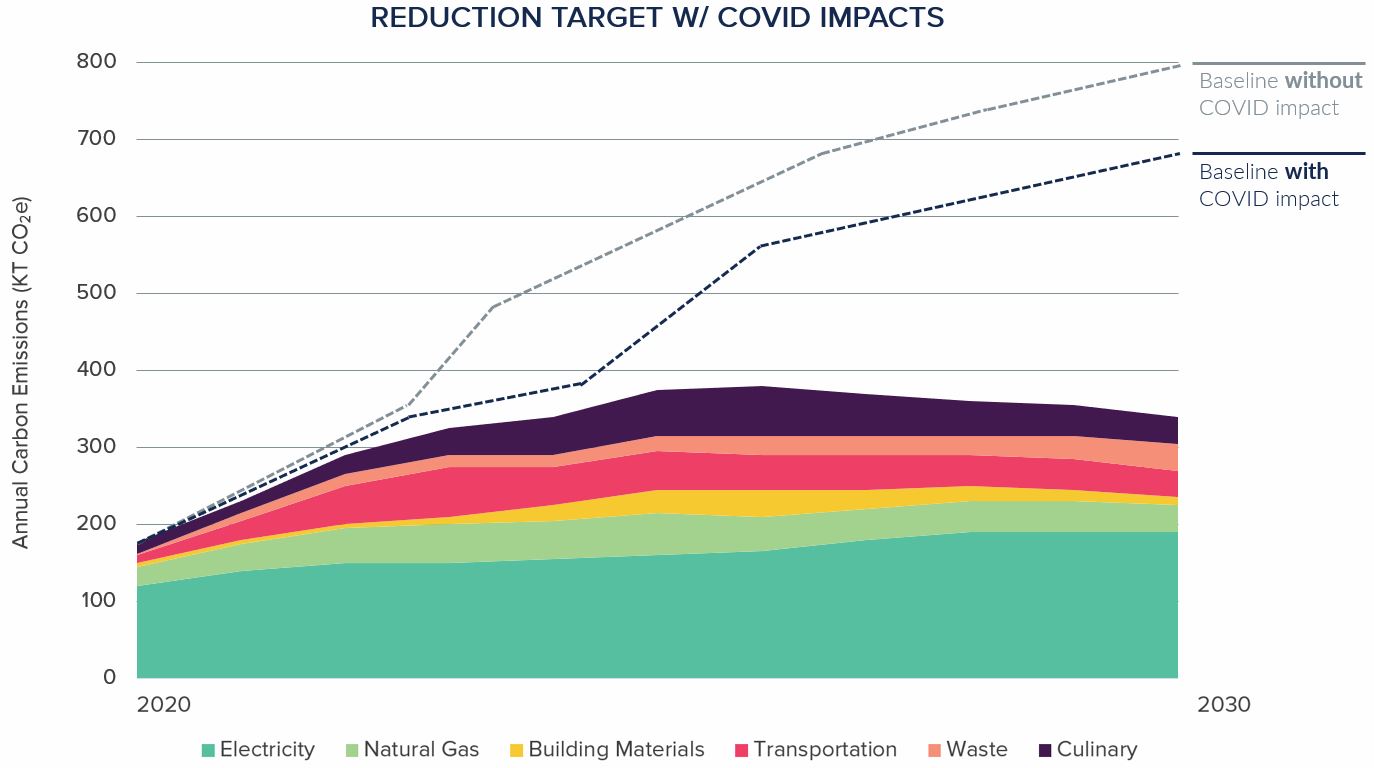The early silver lining of the COVID-19 pandemic was a massive and immediate drop in global carbon emissions, fostering hope that 2020 may in fact be the start of the critical decade of action ahead of many important public and private 2030 climate goals.
With global work-from-home mandates, carbon emissions plummeted at the company level too. Office buildings shifted to operating at base load thus reducing energy use, employees stopped commuting thus wiping out transportation emissions, and emissions associated with in-building services like food and waste zeroed out in empty offices.
But despite the potential “largest ever annual fall in CO2 emissions” triggered by the pandemic, “atmospheric carbon levels are expected to increase again this year” and “will only stabilize once annual emissions reach net-zero,” as stated in an April 2020 Carbon Brief report.
For companies, this means corporate climate commitments and corresponding Carbon Action Plans are more important than ever. And during the pandemic, while your organization’s carbon emissions may have dropped, those emissions haven’t been completely avoided—they’ve been transferred home with your employees.
The big question now is, how do we track these emissions at home? As more organizations begin to embrace full- and part-time remote work as a long term option, consider these actions to accordingly update your Carbon Action Plan.
#1: RESET YOUR BASELINE
The first thing companies should do is consider resetting your baseline to account for our new reality. If, like most, your company set its carbon emissions targets before COVID, the pandemic may have artificially reduced your emissions. To keep on track for long term impact, organizations need to take the next normal into account (i.e. decline in office-related emissions as remote work rises) and reset the baseline so it’s even lower than before.

#2: ACCOUNT FOR HOME CARBON FOOTPRINT
With many companies like tech giants Twitter and Square embracing remote work as a long term option, what happens to corporate emissions when the workplace shifts from office to home? Accounting for your employees’ home carbon footprint will continue to capture emissions data and incentivize finding ways to reduce them from home, strengthening your organization’s climate commitment by expanding your carbon accountability.
You’ll first need to define your boundaries: what portion of remote work carbon impact should your organization include in its carbon accounting? To do this, you will need to consider sources of emissions, spatial boundaries, and temporal boundaries. For sources, energy use (electricity and natural gas) is a good foundation, while some organizations may choose to include emissions associated with waste, food, and consumables. To determine spatial boundaries, identify the portion of the home you’d like to include: just the area around a workstation or the entire home? Finally, determine the relevant time frame: a 40-hour work week or 24/7?
The next step is to account for it. Calculating carbon of remote work is unchartered territory and invariably complex. Much depends on an organization’s willingness and ability to collect data from employees at home. Stok has developed tools and processes to help facilitate and streamline this process.
#3: SEIZE THE OPPORTUNITY FOR EMPLOYEE ENGAGEMENT
Calculating your employees’ home carbon footprint is a daunting task, but it’s also an incredible opportunity to engage employees on direct actions they can take to reduce their—and with it, the organization’s—carbon footprint. Most sustainable actions were previously done at the corporate level, but with more people working from home, organizations can seize a huge engagement and educational opportunity to teach their teams to adopt sustainable practices that go beyond the traditional workplace and into their personal lifestyles at home.
Given the potential challenges caused by remote work, finding opportunities to engage your team from afar is critical. This is a perfect new opportunity for it.
WHAT’S NEXT?
Where and how we work is changing. To keep up, organizations need to rethink carbon beyond the walls of their offices and take responsibility for emissions as they shift home with employees. To do this, we need to figure out how to incorporate employees’ home carbon footprints into your company’s Carbon Action Plan.
We’re excited to be working on solving this problem as well as helping our clients continue to actively track and reduce their corporate carbon emissions. Reach out to the Stok team to learn more about how your company can keep progressing toward your climate commitments during COVID and beyond.


